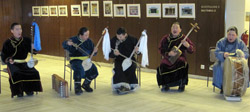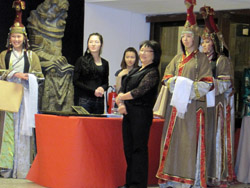|
 Within the Russian House of Science and Culture in Berlin, a great venue for presenting Russian regions to Germany’s capital, the European tour of the Republic of Tuva made a two-day stop on March 15 and 16 to give us a glance into the exotic culture of the very center of Asia – in 2010, the “Year of Tourism” of Tuva. Within the Russian House of Science and Culture in Berlin, a great venue for presenting Russian regions to Germany’s capital, the European tour of the Republic of Tuva made a two-day stop on March 15 and 16 to give us a glance into the exotic culture of the very center of Asia – in 2010, the “Year of Tourism” of Tuva. Before entering the generous exhibition room, five or six young, tall and slim Tuvan models in beautiful traditional clothings (members of the Edegej dance and costumes company) lined the door, while the music ensemble Hogshumchu, consisting of 5 Khomeii master musicians, one of which is Andrei Mongush Aldön-ool (his music-CD “Tuvan throat singing”, featuring spontaneous sessions in Tallin celebrating Dalai Lama’s visit to Estonia), gave the visitors a first impression of Tuvan music folklore – a musical art recognized by the famous Forbes Magazine as absolutely unique and synonymous for Tuva – and having become one of the nine cultural treasures of Tuva.
 Led by the charming Khomushku Oyumaa, Adviser to the Tuvan Minister of Culture and Tourism, the large group of artists from Tuva were introduced by Sergej Churavlov, the Assistant Director of the Russian House. Led by the charming Khomushku Oyumaa, Adviser to the Tuvan Minister of Culture and Tourism, the large group of artists from Tuva were introduced by Sergej Churavlov, the Assistant Director of the Russian House.
First, we were guided through the generous exhibition room where about 40 large black & white photos of Tuva and its people at the beginning of the 20th century were shown against a spectacular contrast of colour photos of Tuva today – including photos of the present Russian Prime Minister, Vladimir Putin, in a meeting with Tuvas head of state, Sholban Kara-ool, as well as a photo of the long-time Russian Minister for Emergy Situations, Sergej Shoigu amidst young volunteers, a Tuvan himself, but also photos of archaeological excavations of the Scythian barrows (kurgans) of Arzhaan II, and of sport events and of ordinary Tuvan people, of herders, nomads and the exciting landscapes – after all, Tuva is the land of the blue rivers! Also exhibited were Tuvan musical instruments such as the igil and others. And in the background, a colourful film about Tuva was shown on a larger screen.
Then the three shamans in traditional clothing with their drums, including the head shaman of the “Spirit Bear” association, performed before us an impressive example of their ritual blessing dances for “cleansing, healing and happiness”.
As well, a table with Tuvan handicrafts, items of art, calendars, books etc. were exhibited which caught the attention of the visitors.
At this very inspiring introductory ceremony, there were many guests attending – journalists including one reporter from the local radio station, people interested in Tuvan culture and traditions, and those who intend to travel to Tuva. They were from Berlin, from Hamburg, from Cottbus, from Dresden – and even a young Tuvinnia by the name of Saylyk Kashbyk-ool with her German husband had travelled to here from Bonn, where she has studied Asian culture at the Bonn University, obtaining her Bachelor of Arts degree, and she is planning to continue her studies for a M.A. in Tuvan history and culture at the University of Bern, the capital city of Switzerland. (It is regrettable that the European tour of the Tuvans did not include a presentation of their culture in Switzerland, because there is a fairly large and distinct community of people being interested in Tuva.)
On the next day, Tuesday, one of the musicians offered master classes for throat singing, and the shamans demonstrated their sacred rituals to interested visitors. And in the evening before a viewership of about 70 people, a much applauded concert of all musicians and other artists, including the famous “Edegej” youth dance ensemble and costumes company, all performing in the Glinka-Musiksalon closed off these two impressive and felicitous days of Tuva in Berlin, leaving us with blissful memories of this event and the desire to see with our own eyes the small Republic of Tuva with its cultural and natural riches. It may be allowed to mention that the Russian House in Berlin should perhaps have beaten the publicity drum more diligently in order to raise more public interest in this wonderful and gratifying event, which has guided us so deeply into the heart of Asia and reminding us of mankind’s origins on this planet.
|
|
